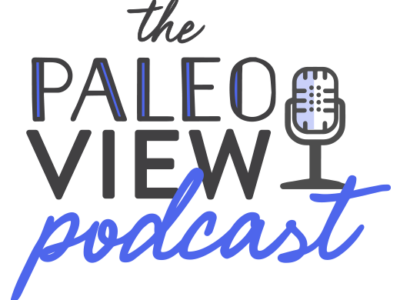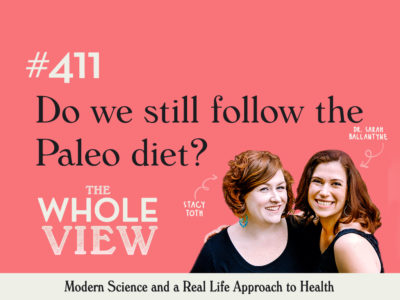In this episode, Stacy and Sarah tackle a collection of questions focused around kid’s nutrition worries, provide tips on feeding picky eaters, and discuss breastfeeding and some tips on weaning.
Click the picture above to be taken to iTunes
or download and listen by clicking the PodBean player below
We’re now on Stitcher!
If you enjoy the show, please review it in iTunes!
The Paleo View (TPV), Episode 41: Kid’s Nutrition, Picky Eaters, Food Sensitivities
- 0:00 – Introduction
- 1:19 – News & Views
- Stacy is feeling kind of whiny from the rain and handling sick kids
- Stacy told Matt she wasn’t feeling good and he made her a pot of stew with heart and she is working on getting a little bit of extra sleep to fight this bug
- Sarah spent five hours outside the day they recorded the podcast, which is the most she has spent outside in 8 months, and her melatonin spike is making her sleepier than usual
- For episode forty-one Sarah and Stacy tackled a collection of questions on tricky kid’s nutrition questions, dealing with picky eaters and general worries about nutrition
- Sarah and Stacy briefly connected on levels of coolness and pop-culture knowledge, aka the usage of phrase ‘tricky-tricky‘. Run DMC was evidently completely left off the Canadian airwaves due to being the complete opposite of Canadian Content.
- Bonus Show Update: iTunes labeled the show as an album, and it has been removed from iTunes due to the cost. However, you can now go to cdbaby or Amazon to purchase the MP3 file of the show
- Thank you to those who purchased the album, we really appreciate it! However, please feel free to use cdbaby or Amazon as the price is what was promised, $0.99 on those two sites
- Folks loved the show and it was a great listen, be sure to check it out
- And a reminder, leaving reviews in iTunes is a huge help to the success of the show – please go into iTunes and click on the stars and leave a review
- These reviews are used in iTunes recommendations and rankings, and can help get this content to others who can benefit from it
- 12:32 – Science with Sarah: Question from Katie: What are the best non-dairy sources of calcium?
- We have discussed that dairy is not as nutritionally dense as other foods on this previous podcast, and we have talked about vitamins and minerals for skin and nail health on this podcast
- We live under an idea that we drink milk for the calcium and it has led to the misconception that there are not other calcium rich foods out there
- A glass of milk, 8 oz. has about 300 milligrams of calcium
- Daily recommended intakes of calcium are different based on age and gender, but caps out at 1300 milligrams per day for adolescent women, women of childbearing age, post menopausal women and people 70 and older
- That is roughly 4 and 1/3 glasses of milk that is recommended in one day
- In half a cup of cooked collard greens there is 210 milligrams of calcium, half cup of cooked kale has 205 milligrams, half cup serving of bok choy has 190 milligrams
- By having some of these green vegetables on your plate, it is essentially the same as a glass of milk
- In addition to dark leafy greens, cruciferous vegetables are high in calcium, vegetables of the allium family are very high in calcium, and so are some root vegetables like rutabagas
- Fish is also a great source of calcium, most of which will have 30 to 80 milligrams of calcium per 4 oz. serving
- Caviar, sardines, and salmon with the bones are all extremely high
- These are just the richest sources, there is also calcium in other vegetables, fruits, nuts and seeds
- Almonds have 93 milligrams in 1/3 cup, sesame seeds have 51 milligrams in one tablespoon, oranges have 52 milligrams of calcium
- If you are eating a Paleo diet with fish, fruits and vegetables it is really easy to hit those targets for calcium intake
- What is great about getting your calcium from fruits and vegetables is that the calcium is easier for your body to absorb and use, while at the same time getting other minerals that are essential to bone health
- Some people may assume that their kids don’t like fish, but you would be surprised that many kids enjoy the salty flavor
- Using bone broth in various recipes is also a great way to get calcium and other minerals into your kids – however the exact nutrient makeup of bone broth varies from batch to batch based on the techniques you use
- Stacy is not concerned about her kids’ bone health as they are all very active and rough and haven’t had an issue – she is confident that they are getting the calcium they need
-

- 24:44 – Q&A
- Christine: How can I best utilize elimination dieting without driving myself and my kids crazy while trying to discover what foods they do and do not tolerate?
- Stacy has put Finian on a modified autoimmune protocol, which really means that they limit his nightshades and try to encourage him to not eat tomatoes
- Ketchup was a hard one for them to give up, but they were able to create an alternative with Paleo mayo (recipe in Eat Like a Dinosaur) that he could dip his food in – guacamole is another great replacement they found
- With something like eczema or skin sensitives, it should be evident pretty quickly if you are making progress
- However, it takes a long time for the gut to heal so you need to incorporate healthy meat and fats, bone broth, fish, quality sleep, in addition to the elimination dieting to truly test how to best resolve intolerances
- Removing FODMAPS and GAPS in a kid should be for extreme cases of gut dysbiosis or problems that are severely related to imbalanced gut health
- Look into foods that have more zinc and magnesium because that will help with sleep
- Stacy wouldn’t put her kids on a supplement, but would instead look for foods that would fill the nutrient gaps
- Stacy also uses Fermented Cod Liver Oil if they haven’t eaten fish in awhile or if they think the kids are fighting a bug
- Sarah also only gives her kids FCLO when they are fighting a bug as well
- Sarah notes that eczema goes along with food sensitivities and suggests that dairy be evaluated, as gluten, dairy and eggs are most commonly linked to eczema – tomatoes are also a good food to test
- Poor sleep could be caused by not getting enough food or the need for some more nutrient dense foods
- Sarah agrees that supplements shouldn’t be given to kids unless in extreme circumstances
- The body is better at regulating vitamins and mineral absorption from food
- If you are working with a good functional medical specialist that is a different situation as they can more closely advise on how to supplement your child’s diet
- Focus on sleep, stress management, time outdoors and what topical products you are using on your son – you may need to replace the chemical products with safer, organic alternatives
- It is easy as a Mom to go crazy trying to figure out what your child needs and what they are sensitive to, so try your best to be patient as time will help show what is happening
- (37:00) Sarah: What are some great sources of fat for a kid, especially one that refuses to eat avocados?
- Since he already enjoys meat focus on high-quality grass-fed and pastured meats
- You can also use naturally fattier cuts of meat in soups, stews, and braised dishes
- Beyond Bacon has great tips on how to purchase whole animals, which is a very affordable option with pasture and grass-fed meats
- Cook in lard, tallow, red palm oil
- Make homemade mayonnaise with olive oil, avocado oil, macadamia nut oil, or walnut oil
- Lots of kids like olives
- There is a recipe in Eat Like a Dinosaur for a chocolate milkshake that uses avocado
- Smoothies with coconut milk are great sources of healthy fats, and help with satiety
- Any kind of seafood is also a great source of fat
- Try not to impose your own likes or dislikes to your kids because their taste buds are very different from an adults, especially since their bodies crave nutrition
- Finally, try not to worry about it, kids tend to eat what their body needs
- Stacy gets her healthy fat from dark chocolate and bacon, kind of joking
- (1:15:22) Rachael: In need of tips on how to handle elimination dieting when breastfed babies appear to have gut issues from something in the mother’s diet.
- Stacy recommends looking at autoimmune recipes on the Paleo Parents site, and keep chocolate out
- It is very common for a mother’s sensitivities to pass through the breast milk to the baby, the mom probably doesn’t realize she is sensitive to these foods and needs to work on healing her gut
- Try removing egg whites, and try to get pastured, soy, wheat free egg yolks
- All of Paleo Parents recipes are soy and dairy free, but check the tag that is for egg-free
- The more you are able to leave out the better, check out both Sarah and Stacy’s autoimmune tags, especially for tasty snack foods
- Eat Like a Dinosaur and Beyond Bacon will also be compatible with elimination dieting needs, and The Paleo Approach will especially be a key resource once available in the fall
- Sarah also recommends adding a probiotic because it will help with both the mother’s and the baby’s gut – talk with your doctor about the best option available
- Be sure to listen to this previous episode where breastfeeding was also discussed
- (50:21) Marcie: Once weaning takes place, do I need to offer my baby a replacement for the breast milk? If sensitive to sauerkraut, what other foods or supplements should I turn to for probiotics? Can you recommend any doctors who specialize in thyroid issues?
- Chris Kresser is taking patients again and could also likely offer some recommendations if he is unable to take her on as a new patient
- Stacy believes in baby initiated weaning between 18 months to two years, most kids decide to wean, but it can also happen anytime between three to six years
- Stacy feels that thirteen months it is a little too early, unless the child is initiating the change
- You do not need to wean to conceive
- If you are trying to get your period back, try to night wean and curb night wakings by offering some water
- Offer only breast milk from a bottle so that the baby doesn’t look to that suckling for comfort
- It might be worth waiting a couple more months to see how your baby’s needs change around 18 months
- You can ferment lots of different foods, it doesn’t have to be cabbage – in Practical Paleo and on Diane’s site Balanced Bites there is information on alternatives to sauerkraut for fermented foods
- Sarah has a recipe for kefir, Stacy has a guest recipe for dairy-free yogurt
- Reduce the sugar volume in your diet to get rid of thrush, you also need to make sure that bottles are disinfected properly
- Some women need a prescription to treat thrush and Stacy recommends Diflucan and Nystatin
- Low selenium is the number one micro-nutrient deficiency that is associated with hyperthyroidism and can be improved with seafood consumption, which also helps with iodine needs
- The other two micro-nutrient deficiencies linked to the thyroid are iron and zinc, which you also get from seafood
- Try throwing in liver once or twice a week, and eat lots of vegetables as well
- Sarah heavily researched goitrogenic vegetables link to thyroid issues and discovered that there is no evidence supporting the removal of those foods if your selenium and iodine status are good
- Soil-based organisms are fantastic and can be consumed through unwashed homegrown organic vegetables, or vegetables from a trusted, local source, or you can take a soil-based probiotic – Sarah takes Perscipt-Assist
- Make sure you check expiration dates on your probiotics to ensure that you have fresh strains of bacteria
- Yes, it is ok to not give your daughter milk, give her water, nut milk or coconut milk, but water is sufficient and is a great habit to develop in your kid
- Baby led weaning is the first opportunity that your kid has to communicate what their dietary needs are
- That is a show. Good night! Good morning! Good day!
- Christine: How can I best utilize elimination dieting without driving myself and my kids crazy while trying to discover what foods they do and do not tolerate?
- 1:14:53 – Outro









